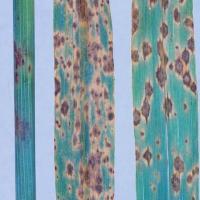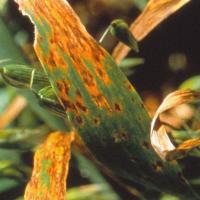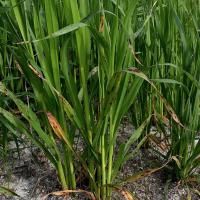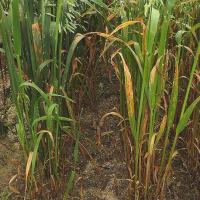Diagnosing septoria avenae blotch in oats
Septoria avenae blotch is the most common oat disease in Western Australia. It occurs throughout the cereal growing areas, and is most severe in the high rainfall areas. Septoria avenae blotch may cause up to 50% yield loss and crop lodging in extreme cases but losses of around 10% are more common in high rainfall areas. Tall or slow maturing oats are less likely to be affected by the disease than short (dwarf) or fast maturing varieties.
What to look for
- Plant with blotched, yellowing and dead leaves evenly distributed across paddock.
Paddock
- Symptoms begin as small dark-brown to purple, oval or elongated spots on leaves.
Spots grow into larger light or dark-brown blotches with surrounding yellow areas that can cover and kill the entire leaf.
Infection may spread to leaf sheaths and through them to stems, where greyish-brown or shiny black lesions nay cause lodging.
Dark-brown blotches can also occur on the head and grain.
Plant
What else could it be
| Condition | Similarities | Differences |
|---|---|---|
| Diagnosing halo blight in oats | Halo blight also causes red-brown lesions with yellow edges and leaf tip death, but lesions are surrounded by a water-soaked ring |
Where does it occur?
- The disease is caused by the fungus Phaeosphaeria avenaria f.sp. avenaria (asexual stage: Stagonospora (formerly Septoria) avenae f.sp. avenaria). It is not one of the septoria diseases of wheat, which are caused by different organisms.
- Infected stubble is the main source of carryover infection from one season to another. The sexual stage of the fungus, Phaeosphaeria avenaria, occurs on infested stubble and produces ascospores which are spread moderate distances by wind. Oat stubbles in paddocks rotating from oat probably contribute most of the inoculum to nearby paddocks. In multiple cropped oats where stubble is not destroyed, ascospores land on the new crop in much larger quantities, resulting in the development of earlier and more severe outbreaks.
- During the season, the fungus on diseased plants produces splash-borne pycnidio- spores which spread the disease onto new foliage during rain. These spores do not move between paddocks but may also be produced by infested stubble residues and contribute to the development of new disease in multiple cropped oats.
Where did it come from?
- Disease inoculum carried between seasons on infected stubble.
- After rain, fungal spores are ejected from sexual fruiting bodies on stubble and may be spread considerable distances on wind. Secondary generation of asexual spores occurs in black fruiting bodies on blotched leaves which are then locally dispersed within the crop by rainsplash, infecting new leaves.
- Most active in mild conditions and becomes less active towards the end of the season, except in cool areas.
- Rain splash responsible for spreading fungal spores and the disease within crops.
Management strategies

Spraying foliar

Resistant varieties

Rotation
- Foliar sprays can control the disease but are only economic when conditions favour disease spread.
- Use more resistant varieties in disease-prone areas, if suitable agronomic types are available.
- Disease can be minimised by not growing continuous oat crops. In continuous oat cropping, stubble from diseased plants should be destroyed by burning or ploughing. Burning is not advised on light soils subject to wind or water erosion.
Economic and financial considerations
To assist in assessing the economic risk and financial costs associated with various treatment strategies go to MyEconomicTool.
There may be other economic and financial implications that need to be considered when choosing a management option.
Where to go for expert help
Page last updated: Friday, 19 February 2016 - 2:35pm




